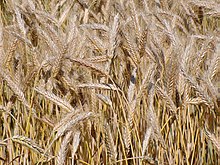Triticale
| Triticale | |
|---|---|
 |
|
| Triticale | |
| Scientific classification | |
| Kingdom: | Plantae |
| (unranked): | Angiosperms |
| (unranked): | Monocots |
| (unranked): | Commelinids |
| Order: | Poales |
| Family: | Poaceae |
| Tribe: | Triticeae |
| Genus: | × Triticosecale |
| Binomial name | |
|
× Triticosecale Wittm. ex A. Camus. |
|
| Species | |
|
see text |
|
| Synonyms | |
|
× Triticale Tscherm.-Seys. ex Müntzing |
|
|
Top Triticale producers in 2014 |
|
| (million metric tons) | |
|
|
5.2 |
|
|
3.0 |
|
|
2.1 |
|
|
2.0 |
|
|
0.7 |
|
|
0.5 |
|
|
0.5 |
|
|
0.4 |
|
|
0.4 |
|
|
0.3 |
| World total | 17.1 |
| Source: UN Food & Agriculture Organisation (FAO)[1] |
|
see text
× Triticale Tscherm.-Seys. ex Müntzing
Triticale (× Triticosecale), /trɪtɪˈkeɪliː/ is a hybrid of wheat (Triticum) and rye (Secale) first bred in laboratories during the late 19th century in Scotland and Germany. Commercially available triticale is almost always a second-generation hybrid, i.e., a cross between two kinds of primary (first-cross) triticales. As a rule, triticale combines the yield potential and grain quality of wheat with the disease and environmental tolerance (including soil conditions) of rye. Only recently has it been developed into a commercially viable crop. Depending on the cultivar, triticale can more or less resemble either of its parents. It is grown mostly for forage or fodder, although some triticale-based foods can be purchased at health food stores or are to be found in some breakfast cereals.
When crossing wheat and rye, wheat is used as the female parent and rye as the male parent (pollen donor). The resulting hybrid is sterile and must be treated with colchicine to induce polyploidy and thus the ability to reproduce itself.
The primary producers of triticale are Poland, Germany, Belarus, France and Russia. In 2014, according to the Food and Agriculture Organization (FAO), 17.1 million tons were harvested in 37 countries across the world.
...
Wikipedia
